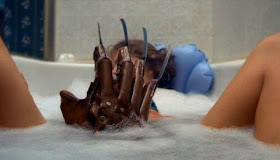A Nightmare on Elm Street is one of my favourite films. It isn't perfect, but it is one of those beautiful and interesting messes. Every time I re-watch it I am again impressed with its visual imagination and bewildered by its depiction of women.

Tina's nightmare in the opening sets the stage with a subtlety that is unexpected for a scene where a dude with knives for fingers is hunting a girl in a nightie. But the movie's dream world is almost impressionistic in some of its details. She's in a creepy boiler room, wandering around dressed for bed, and when she turns to a shocking sound, it's a lamb in the wet hallway, braying at her. The lamb's back-lit, just a clattering silhouette, and then it's gone. It's never seen or mentioned again, though it is heard mixed in with the music of later scenes. Horror movies are full of those nonsensical scares, a loud startling sound that turns out to be something innocuous. Here it is something innocuous but surreal, so that you are still relieved, but also a bit uncertain. It is a perfect note, making this all feel authentically dreamlike.
The real world of the movie is less compelling, though there are some interesting characterization choices. Nancy is the main character, an all-American girl next door, and a strong survivor by the end of the film. Johnny Depp is strangely effective as her dipshit jock boyfriend Glen, though not for the reasons intended. He's a non-character, with no motivation aside from wanting to get in Nancy's pants. Glen doesn't have any kind of internal life. With Nancy's slutty friend Tina we at least get to see her nightmares. Glen is just arm candy. (His wardrobe is a bimbo wardrobe, right down to showing his midriff). He's effective at highlighting Nancy's ability to defend herself.

His dialogue and behavior is written as though he forgets that he's actually having these nightmares too. When Nancy does need to ask him for his help, he doesn't take her seriously. She needs him to stay awake and pull her out of the dream if she seems like she's in trouble. He nods and smiles and tells her what she wants to hear and then just goes to sleep anyway. A couple days later, when he finds her reading books on improvised booby traps and anti-personnel devices, he laughs it off. Their friends are dying, but it's still weird that Nancy's learning to defend herself? Meanwhile this scene gives Nancy one of the most effective and awesome lines in the movie: "I'm into survival."
Nancy struggles to understand what is happening to her, and then takes steps to find and implement a solution. She gets shit done. That said, you can't exactly call this a feminist movie. There are a lot of horror tropes at work here that undermine the strong female lead.
The flip side to the strong survivor female in horror movies is that women are constantly under threat. Throughout you only see Tina and Nancy's dreams. The male characters are having nightmares too, but it's scarier to show Tina and Nancy being threatened. That lends the horror a sexual tone, the most obviously sexual example being the scene where Freddy's claw comes up between Nancy's legs in the bath. That's where her vagina is, in case you didn't know!
But that bathtub scene is also brilliant. It plays with space in a way that appeals to the little kid part of my brain. His hand is raising from a place where he couldn't possibly be. There's no room for a whole man and his hat in that shallow tub! Then Nancy gets pulled under the water, and you see from below that it's a whole dark ocean that she's being pulled down into. It's exactly the sort of unexpected detail that gives the nightmares in the movie the flavour of real dreams.
The second movie in the Nightmare series, Freddy's Revenge, is famously full of homoerotic imagery, and takes almost the same sexual threat approach, but with the male characters as victims as well as aggressors. (Also, they take a lot of cues from Glen's wardrobe!) And it could always have been worse. The horror novelist Richard Laymon writes tense, compulsively readable books, but they are books that make me much more directly uncomfortable. His female protagonists face down psychotic killers and the supernatural, but are often under the explicit and constant threat of sexual violence. And then men usually save them in the end anyway.
But it's not much of a defense to say that it could be worse - and a sequel turning the formula on its head doesn't erase the original's flaws. It's difficult to praise a movie for its portrayal of a strong female when that same movie elicits thrills from the audience by getting her naked and then threatening her vagina with knives.
Still, it is undeniably effective on a purely visceral level to have the female characters in danger. Whether this is a byproduct of sexism or not, it gets the reactions it wants to get from audiences. And it is a movie that still manages to surprise and impress me with its visual style and its imagination. Flaws and all, I wish more movies were this good.











